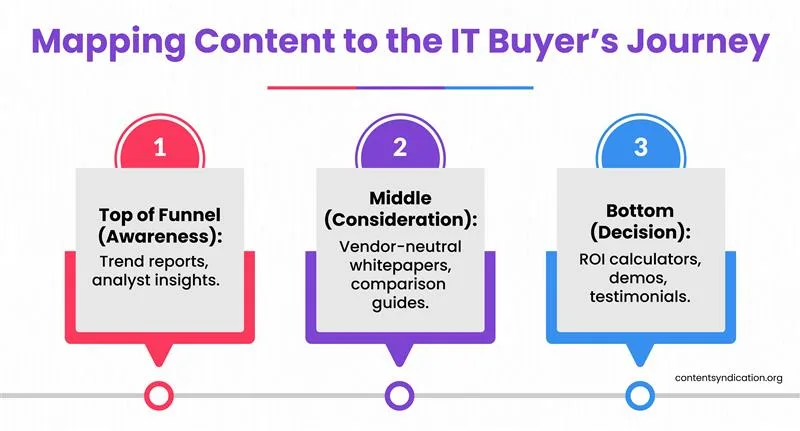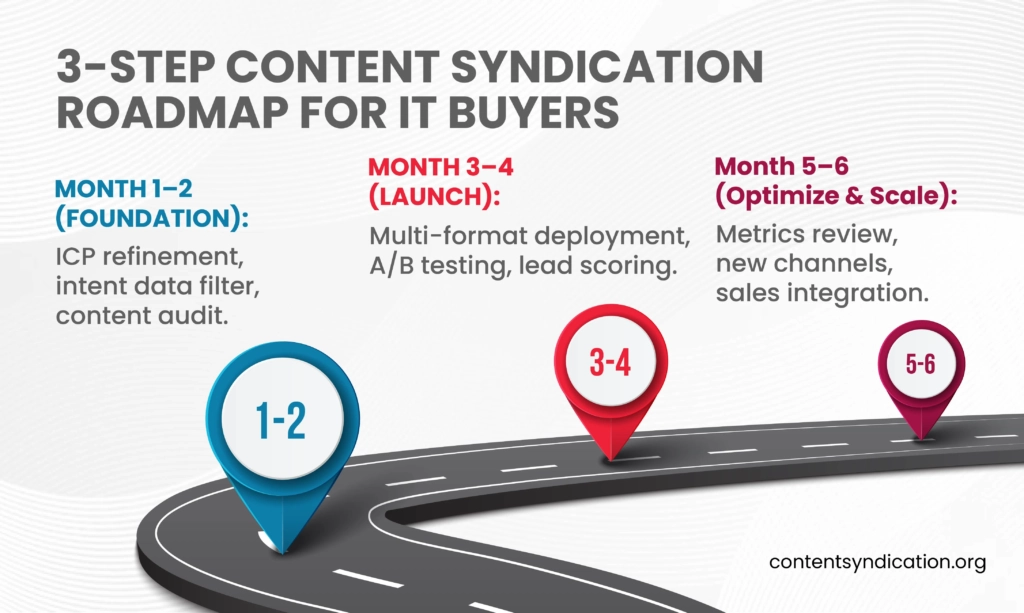If you are still relying on cold calling or email blasts, you may have already noticed that these tactics no longer work as they once did.
Why? Because buyer behavior has changed. Their journey is now self-directed, and traditional methods no longer align with modern buying behavior.
By the time your sales team reaches a prospect, buyers are already 57–70% through their journey. They’ve done their research, compared competitors, and often formed preferences.
With content syndication, you ensure that you remain top of mind throughout most of their journey. This gives you the opportunity to showcase your value-driven resources in the spaces where IT buyers are already researching.
So, let’s unravel buyer behavior to understand what works best for them.
2. Meet Your Modern IT Buyer
The Research-First CIO
CIOs are cautious and analytical. They consume around eight content assets before engaging with a vendor.
And no, CIOs are not too busy for deep content. In fact, they depend on it to reduce risk. They’re looking for industry insights, benchmarks, and credible sources — not sales collateral.
The Skeptical CTO
CTOs are deep evaluators. They push aside surface-level claims and fluffy marketing content. What they value are in-depth case studies, integration guides, and peer recommendations.
The Budget-Conscious Procurement Head
Procurement teams face mounting pressure to justify every investment. Vendors often assume these stakeholders only come in late, but in reality, they influence buying decisions much earlier.
They want to validate ROI. Syndicating ROI calculators, cost-benefit reports, and customer testimonials helps procurement advocate internally.
3. Mapping Content to the IT Buyer’s Journey

Awareness Stage (Problem Recognition)
Jumping to product information immediately often leads to premature rejection. Yes, buyers are aware of their challenges, but that doesn’t mean you should start pitching.
Instead, focus on syndicating industry trend reports, analyst insights, and educational blog series through trusted platforms.
Consideration Stage (Solution Evaluation)
As buyers evaluate options, they seek neutrality and clarity. Overloading them with overly branded assets creates skepticism.
Buyers want vendor-neutral comparison guides, whitepapers, and case studies that show solutions in action without aggressive promotion.
Decision Stage (Vendor Selection)
At this stage, buyers seek validation: ROI numbers, peer testimonials, and evidence of implementation success.
Technical specs aren’t enough. You should syndicate ROI calculators, demos, and testimonials.
This can be done through direct outreach, gated webinars, and analyst-driven platforms —reassuring stakeholders and accelerating deal closure.
When content is mapped thoughtfully, IT services firms don’t just meet buyer needs — they dismantle misconceptions and remove friction points at every stage.
4. The Syndication Journey for IT Buyers

Month 1–2: Foundation Building
Poor targeting is a major challenge. Wrong targeting wastes resources and leads to sales burnout.
To avoid irrelevant leads, run your lists through an intent data filter. Once refined, build a content audit that emphasizes problem-solving insights instead of promotional pitches.
Month 3–4: Campaign Launch
Syndication is not about showing maximum visibility by pushing the same content everywhere and expecting results.
Format and platform alignment makes all the difference. Whitepapers may work in professional forums, while ROI tools are better gated behind targeted landing pages.
Don’t skip A/B testing or lead scoring adjustments. Skipping these steps generates high volumes of low-quality leads—frustrating both marketing and sales.
Month 5–6: Optimization & Scale
Proving ROI is the ultimate test and it’s not tied to lead volume alone. The real game lies in connecting syndicated leads to pipeline growth and closed deals.
Firms that continuously review metrics, optimize targeting, and expand into new vertical-specific channels see stronger outcomes.
Sales integration is vital. Without context (what content a lead consumed, or which pain points they engaged with), follow-ups risk feeling generic.
Successful IT firms recognize that syndication is not a one-off tactic but an iterative journey. Continuous refinement and scaling are what drive sustainable results.
5. Measuring Success Throughout the Journey
Successful syndication doesn’t automatically equal business success. Many IT services firms celebrate high MQL volumes, but this often falls flat when sales dismiss those leads as unqualified.
Leading indicators — like CTRs and download rates highlight engagement but don’t prove business impact on their own.
Mid-funnel metrics carry more weight. MQL-to-SQL conversion is the true success measure. Falling short often signals poor targeting or a content mismatch.
Lagging indicators prove ROI: pipeline value, opportunities created and closed-won revenue remain the ultimate measures of impact.
Attribution can be tricky, but with UTM tagging and CRM integration, ROI tracking becomes straightforward.
Holistic measurement is the key. Measure success across the funnel, that’s how you overcome the volume-vs-quality tension and bring marketing and sales into true alignment.
6. Journey Challenges & Navigation Tips
Long sales cycles, multiple stakeholders, and technical complexity make IT buying notoriously difficult.
And no, one great asset cannot close a deal. In truth, buyers need multiple tailored touchpoints across months of nurturing.
Instead, syndication should deliver layered content: executive briefs for leadership, technical papers for engineers, and ROI models for procurement.
This multi-layered approach prevents buyers from stalling or disengaging. It’s also a way of matching the right content to the right persona at the right moment.
7. The Continuous Improvement Loop
Syndication isn’t just another tactic. It’s a strategic shift. Buyer behavior evolves, industries shift, and what resonated last quarter may underperform today. Without continuous optimization, even strong campaigns lose relevance.
By regularly auditing ICPs, refreshing assets, testing channels, and integrating emerging tools like AI-driven personalization, IT firms maintain momentum.
This improvement loop transforms syndication from a one-off tactic into a long-term growth driver.
What is B2B Content Syndication for IT Services Firms?
B2B content syndication for IT services firms is the process of distributing whitepapers, case studies, ROI tools, and other valuable assets across trusted platforms to reach niche IT buyers. It helps generate qualified leads, build brand trust, and accelerate pipeline growth.
How does content syndication help IT firms reach niche buyers?
IT buyers, such as CIOs, CTOs, and procurement teams, rely on research-first content. Syndication ensures your assets appear on the channels they trust, analyst reports, comparison guides, and industry platforms, guiding them from awareness to decision.
What types of content work best for IT buyer syndication?
The most effective assets include:
- Decision stage: ROI calculators, demos, testimonials
- Awareness stage: Trend reports, analyst insights
- Consideration stage: Vendor-neutral whitepapers, comparison guides
How do IT services firms measure ROI from content syndication?
ROI is measured by tracking MQL-to-SQL conversion rates, pipeline value, opportunities created, and closed-won deals. CRM integration and UTM tagging make ROI attribution clear and accurate.
Is B2B content syndication better than cold calling or email blasts?
Yes, Syndication aligns with modern IT buyer behavior, where prospects complete 57–70% of their research before engaging vendors. Unlike cold calls, syndication builds trust by meeting buyers where they’re already looking.
Conclusion
IT buyers aren’t waiting for your sales call. They discover, compare, and decide long before outreach begins.
Content syndication is your chance to meet them where they are, build trust, and guide their choices. The next step is clear: stop chasing buyers and start showing up where they’re already looking.




